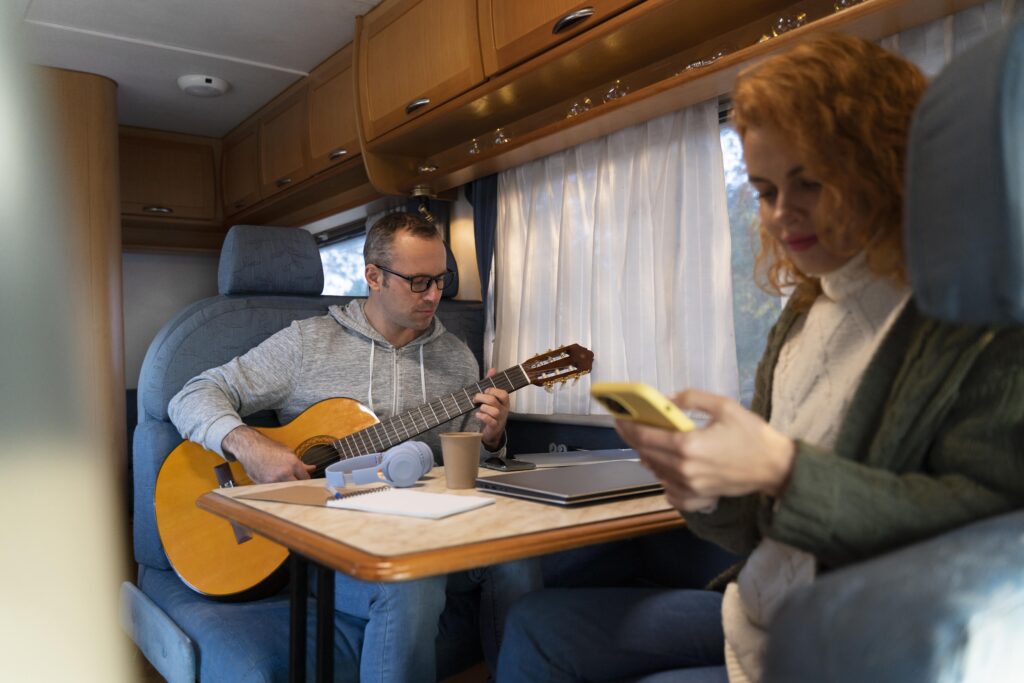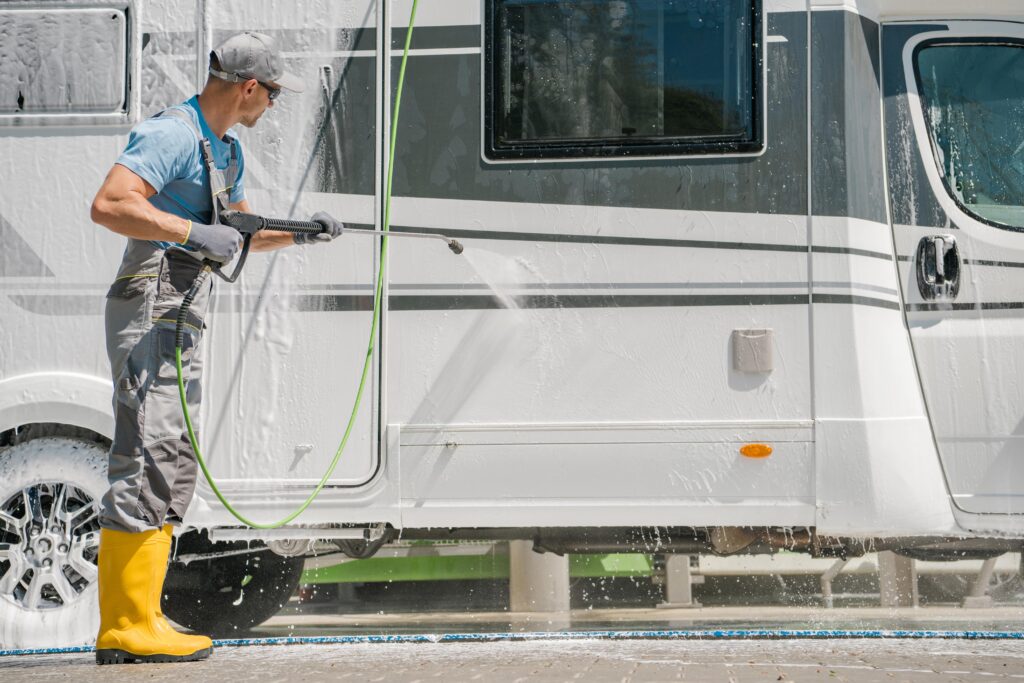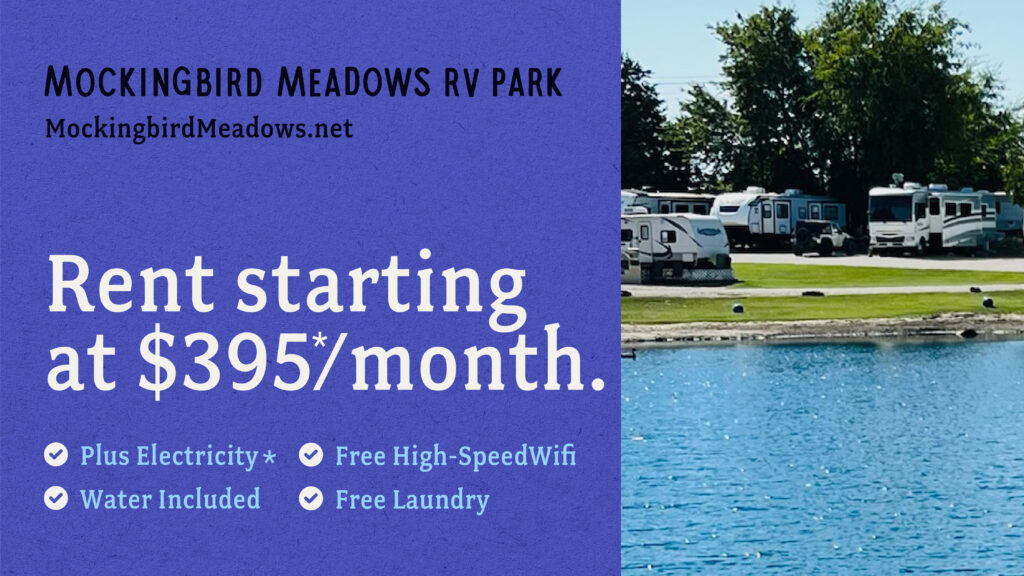
Top 10 Questions to Ask Before Committing to Long-Term RV Living
April 24, 2024
Long-term RV living can be an exciting and adventurous lifestyle, but it’s not for everyone. Before making the commitment to live on the road, there are important questions to ask to ensure that it’s the right choice. These questions cover a range of topics, from finances to logistics to personal preferences.

One of the first questions to consider is whether long-term RV living is financially feasible. This lifestyle can be less expensive than traditional living, but it’s important to have a realistic budget and plan for unexpected expenses. Another important consideration is the type of RV to live in, as different models have different features and benefits. It’s important to research and choose a model that fits both personal preferences and practical needs.
Other important questions to ask include how to handle mail and bills while on the road, how to stay connected with family and friends, and how to find work or income sources while traveling. Additionally, it’s important to consider personal preferences for things like travel destinations, lifestyle habits, and social interaction. By asking these questions and carefully considering the answers, individuals can make an informed decision about whether long-term RV living is right for them.
Evaluating Your Readiness for RV Living

Assessing Personal Flexibility
Long-term RV living requires a lot of flexibility, both in terms of daily routines and long-term plans. Individuals who thrive in this lifestyle are often those who can adapt to change easily and are comfortable with uncertainty. There are many benefits of living in an RV full time. Before committing to full-time RV living, individuals should assess their personal flexibility and consider whether they will be able to handle the challenges that come with this lifestyle.
One way to assess personal flexibility is to evaluate how well an individual handles unexpected situations. For example, if a person is uncomfortable with last-minute changes or deviations from a planned itinerary, they may struggle with RV living. On the other hand, those who are comfortable with spontaneity and can easily adjust to new situations will likely thrive in this lifestyle.
Understanding the Commitment Required
Long-term RV living requires a significant commitment of time, energy, and resources. Individuals should carefully consider whether they are willing and able to make this commitment before embarking on this lifestyle.
To understand the commitment required, you should consider factors such as the cost of RV ownership and maintenance, the time required to plan and execute travel itineraries, and the potential impact on personal relationships and social connections. It is also important to consider the physical and emotional demands of RV living, such as the need to be self-sufficient and the potential for isolation and loneliness.
By carefully evaluating their personal flexibility and understanding the commitment required, individuals can make an informed decision about whether long-term RV living is the right choice for them.
Financial Considerations

Budgeting for the RV Lifestyle
Before committing to long-term RV living, it’s important to create a realistic budget that takes into account all of the associated costs. Some of the expenses to consider include the cost of the RV itself, maintenance and repairs, fuel, insurance, campground fees, and food.
To create a budget, start by estimating your monthly income and then subtracting your monthly expenses. Be sure to include any debt payments or other financial obligations you may have. Once you have a clear picture of your income and expenses, you can adjust your spending as needed to make sure you can afford the RV lifestyle.
Analyzing Long-Term Expenses
In addition to the monthly expenses associated with RV living, it’s important to consider the long-term costs as well. For example, RVs typically have a lifespan of around 20 years, so you’ll need to plan for the cost of replacing your RV at some point in the future.
Other long-term expenses to consider include the cost of upgrades and renovations, as well as the cost of storing your RV during the off-season. It’s also important to consider the potential impact of inflation on your expenses over time.
By taking the time to carefully analyze your expenses and plan for the long-term, you can ensure that you’re financially prepared for the RV lifestyle.
Choosing the Right RV

When it comes to choosing the right RV for long-term living, there are several factors to consider. Here are some important things to keep in mind:
Size and Amenities
One of the most important factors to consider when choosing an RV for long-term living is size. While larger RVs may provide more space and amenities, they can also be more difficult to maneuver and park. On the other hand, smaller RVs may be easier to drive and park, but may not have as many amenities or as much living space.
When considering the size of an RV, it’s important to think about the number of people who will be living in the RV and their individual needs. For example, families with children may need more sleeping space, while retirees may prioritize comfort and luxury amenities.
New vs. Used RV Pros and Cons
Another important factor to consider when choosing an RV for long-term living is whether to buy new or used. There are pros and cons to both options.
New RVs come with the latest features and technologies, and typically come with a warranty. However, they can also be more expensive than used RVs.
Used RVs can be more affordable, but may require more maintenance and repairs. It’s important to thoroughly inspect a used RV before purchasing to ensure that it’s in good condition.
Overall, choosing the right RV for long-term living requires careful consideration of individual needs and preferences. By taking the time to research and weigh the pros and cons of different options, individuals can find an RV that meets their needs and provides a comfortable home on the road.
Lifestyle Adjustments

Adapting to Smaller Living Spaces
One of the biggest lifestyle adjustments when committing to long-term RV living is adapting to smaller living spaces. RVs come in all shapes and sizes, but even the largest RVs have significantly less space than a typical house or apartment. It’s important to consider what items are necessary and what can be left behind. Creating a list of essentials and downsizing belongings can help make the transition smoother.
Another way to adapt to smaller living spaces is to maximize storage. RVs often have hidden storage compartments and creative storage solutions, such as under-bed storage or hanging organizers. Utilizing these spaces can help keep RVs organized and clutter-free.
Maintaining Social Connections
Long-term RV living can be isolating, especially if one is used to living in a community or surrounded by family and friends. Maintaining social connections is important for mental health and well-being.
One way to maintain social connections is to join RVing communities or clubs. These communities often have organized events and activities, providing opportunities to meet new people and make friends. Social media can also be a great tool to connect with other RVers and stay in touch with family and friends.
It’s important to remember that maintaining social connections may require more effort and planning when living on the road. Making an effort to stay in touch with loved ones and actively seeking out social opportunities can help combat feelings of isolation.
Healthcare and Emergency Planning

Long-term RV living can be an exciting and fulfilling lifestyle, but it’s important to consider healthcare and emergency planning before committing to this lifestyle. This section covers two essential aspects of healthcare and emergency planning: accessing medical services on the road and emergency preparedness.
Accessing Medical Services on the Road
One of the biggest challenges of long-term RV living is accessing medical services while on the road. It’s important to research and plan ahead to ensure you have access to medical care when you need it. Here are a few things to consider:
- Health Insurance: Make sure you have adequate health insurance coverage for your travels. Some health insurance plans may not cover you while traveling out of state or out of the country, so be sure to check with your provider.
- Telemedicine: Consider signing up for telemedicine services that allow you to consult with a doctor remotely. This can be a convenient option for minor health issues or follow-up appointments.
- Urgent Care Centers: Research urgent care centers along your route and keep their contact information handy in case of an emergency.
- Prescriptions: Make sure you have an adequate supply of any prescription medications you need before hitting the road. You may also want to consider mail-order prescriptions or using a pharmacy chain with locations nationwide.
Emergency Preparedness
It’s important to have a plan in place for emergencies while on the road. Here are a few things to consider:
- Emergency Kit: Keep an emergency kit in your RV that includes first aid supplies, flashlights, batteries, a portable radio, and non-perishable food and water.
- Communication: Make sure you have a way to communicate in case of an emergency. This could include a cell phone, satellite phone, or two-way radio.
- Weather Alerts: Sign up for weather alerts for the areas you’ll be traveling through. This can help you avoid severe weather and plan your route accordingly.
- Campground Information: Research campgrounds along your route and make note of their emergency procedures and contact information.
By considering these healthcare and emergency planning factors, you can enjoy a safe and fulfilling long-term RV living experience.
Connectivity and Remote Work

Long-term RV living can offer an incredible sense of freedom, but it’s important to consider how you’ll stay connected to the internet while traveling and how you’ll balance work with your travel schedule.
Internet Access While Traveling
One of the biggest concerns for remote workers living in an RV is reliable internet access. While many RV parks and campgrounds offer Wi-Fi, it’s important to note that the quality of the connection can vary greatly. In addition, some parks may limit the amount of data you can use each day, which can be a problem if you rely heavily on video conferencing or other data-intensive tasks.
To ensure you have reliable internet access, it’s important to research and invest in a good mobile hotspot or cellular data plan. You may also want to consider using a signal booster to improve your connection in areas with poor coverage.
Balancing Work and Travel
While long-term RV living can be a great way to see the country, it’s important to remember that work still needs to come first. It’s easy to get caught up in the excitement of travel and neglect your work responsibilities, but this can quickly lead to problems.
To balance work and travel, it’s important to set clear boundaries and establish a routine. This might mean dedicating specific hours each day to work and planning your travel around those hours. It can also be helpful to find a quiet workspace within your RV or at a nearby co-working space.
By prioritizing reliable internet access and finding a balance between work and travel, remote workers can enjoy the freedom and adventure of long-term RV living without sacrificing their professional goals.
Maintenance and Upkeep

Routine RV Maintenance
When committing to long-term RV living, it is important to understand the routine maintenance that is required to keep your RV in good condition. Regular maintenance can help prevent expensive repairs and extend the lifespan of your RV.
Some routine maintenance tasks include checking and changing the oil, inspecting the brakes, testing the battery, and checking the tire pressure. It is also important to regularly clean the RV inside and out to prevent damage from dirt and grime.
Creating a maintenance schedule and sticking to it can help ensure that your RV stays in good condition and is safe to travel in.
Handling Repairs During Travels
While routine maintenance can help prevent breakdowns, unexpected repairs may still arise during travels. It is important to be prepared and know how to handle repairs while on the road.
Having a basic toolkit and spare parts on hand can be helpful for minor repairs. It is also important to have a plan in place for major repairs, such as knowing where to take your RV for service and having a backup plan for accommodations if your RV needs to be in the shop for an extended period of time.
Additionally, having a roadside assistance plan can provide peace of mind and help with unexpected breakdowns or accidents.
There are many pros and cons of long-term RV living, but by understanding the basic maintenance and having a plan in place for unexpected repairs, long-term RV living can be a rewarding experience.
Location Independence

When committing to long-term RV living, one of the most important considerations is location independence. This means being able to travel and live anywhere, without being tied down to a specific location.
Finding Campsites and Parking
To achieve location independence, you’ll need to find campsites and parking spots that are safe, affordable, and conveniently located. One option is to use a mobile app or website that provides information on RV-friendly campsites and parking spots. Some popular options include RV Parky, Campendium, and AllStays. These resources can help RVers find campsites and parking spots that meet their specific needs, such as proximity to attractions or availability of amenities like water and electricity.
Another option is to join a membership program like Thousand Trails or Escapees, which offer access to a network of RV parks and campgrounds across the country. These programs can be a cost-effective way to find safe and reliable places to park your RV, while also providing access to a community of fellow RVers.
Navigating Seasonal Changes
When living in an RV, it is important to be prepared for seasonal changes. This means having the right equipment and supplies to stay comfortable in different weather conditions. For example, during the summer months, it may be necessary to have a portable air conditioning unit or fan to stay cool. In the winter, a space heater and extra blankets can help keep you warm.
It is also important to consider the location of your RV during different seasons. For example, during hurricane season, it may be wise to avoid coastal areas that are prone to flooding and high winds. Similarly, during the winter months, it may be necessary to head south to avoid snow and ice.
By staying flexible and prepared, RVers can enjoy location independence and the freedom to travel and live anywhere they choose.
Frequently Asked Questions

What are the monthly costs associated with full-time RV living?
Monthly costs for full-time RV living vary depending on several factors such as the type of RV, location, and lifestyle. On average, RVers spend between $1,400 to $3,000 per month on expenses including campground fees, fuel, maintenance, and food. It is important to budget for unexpected expenses such as repairs and emergencies.
How do I prepare for a stationary full-time RV lifestyle?
To prepare for a stationary full-time RV lifestyle, it is important to research and choose a suitable location that meets your needs and preferences. This includes considering factors such as climate, proximity to amenities, and safety. Additionally, it is important to have a plan for waste disposal and access to utilities such as water and electricity.
What are the legal considerations of living in an RV full-time on private land?
The legal considerations of living in an RV full-time on private land vary depending on the location and local zoning laws. It is important to research and understand the laws and regulations in the area where you plan to live. Some areas may require permits or have restrictions on the length of time you can stay in an RV.
What factors should I consider when choosing an RV for full-time living?
When choosing an RV for full-time living, it is important to consider factors such as size, layout, and amenities. A larger RV may provide more space and comfort, but may also be more difficult to maneuver and park. Additionally, it is important to consider the quality and durability of the RV to ensure it can withstand full-time use.
What are the common challenges faced by those living in an RV full-time?
Common challenges faced by those living in an RV full-time include limited space and storage, maintenance and repair issues, and adjusting to a new lifestyle. It is important to have a plan for addressing these challenges and to be flexible and adaptable.
How does the 3 3 3 rule apply to full-time RV living?
The 3 3 3 rule is a guideline for full-time RVers to help manage expenses and avoid burnout. The rule suggests spending no more than three hours driving per day, staying at each location for at least three days, and planning at least three months in advance. Following this rule can help RVers stay organized and enjoy the full-time RV lifestyle.
Mockingbird Meadows RV Park

Mockingbird Meadows RV Park is a family owned and operated RV Park near Dallas, TX. We are not just a group of RV owners; we have built a warm and welcoming community that feels like family. We’re committed to keeping our RV grounds in top shape with regular upkeep and repair for everyone to enjoy. Throughout the year, we organize fun events like block parties, barbecues, and holiday light shows to bring us all together. We invite you to explore our community and discover what makes it truly special.
❗Rent Starting at $395/month❗Visit our Website: www.mockingbirdmeadows.net
Call Us: (903)340-9659
See our Reviews: https://maps.app.goo.gl/QHpzcvh2oeF1HkhV7
Let us know if you have any questions.
(903) 662 7778
4846 Co Rd 3408, Lone Oak, TX 75453
Click Here to Email Us
Comments Off on Top 10 Questions to Ask Before Committing to Long-Term RV Living